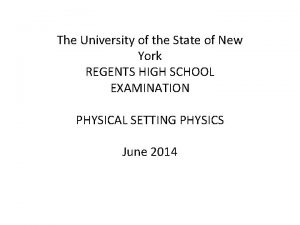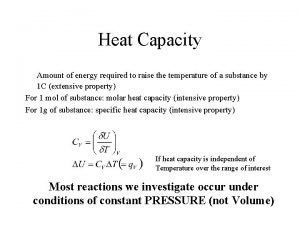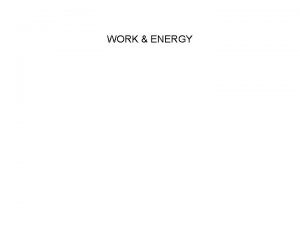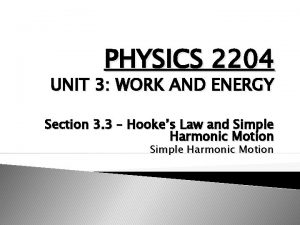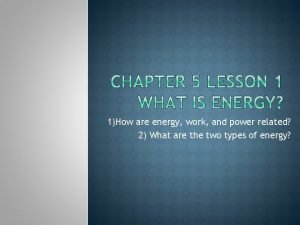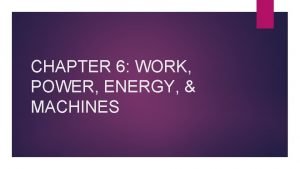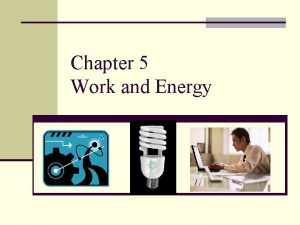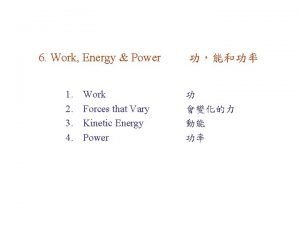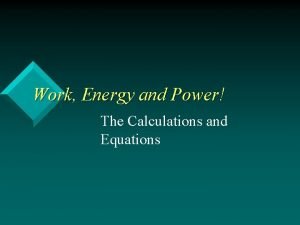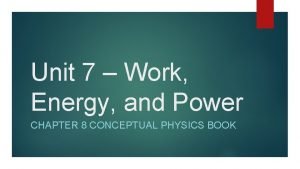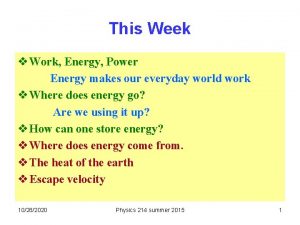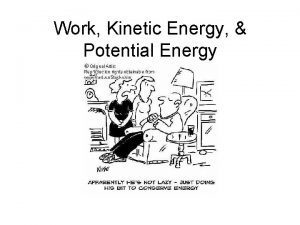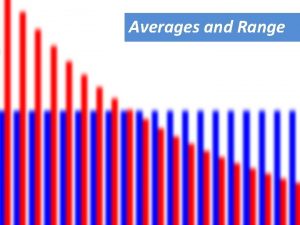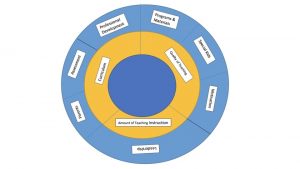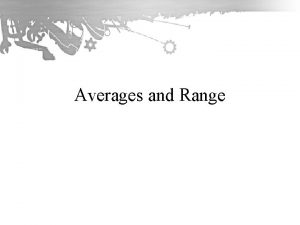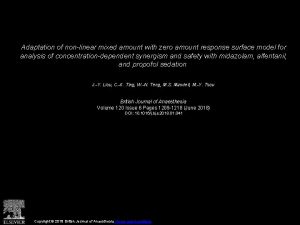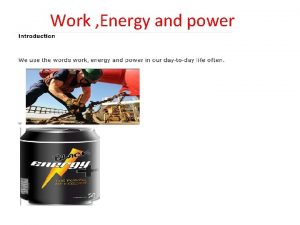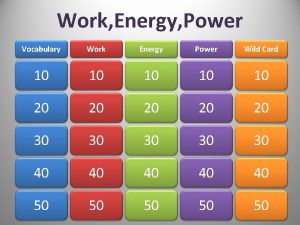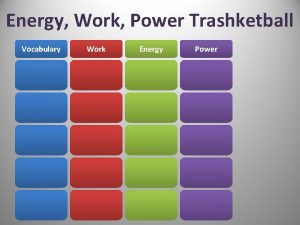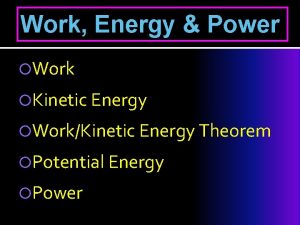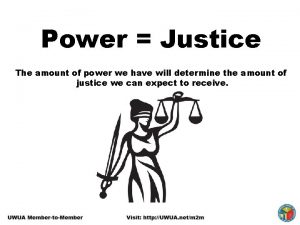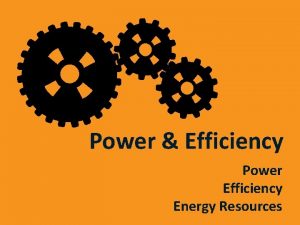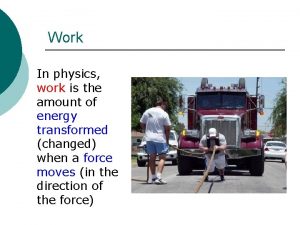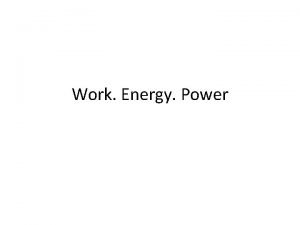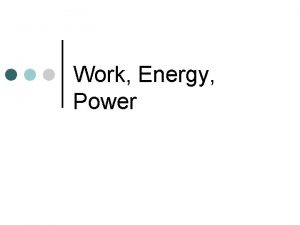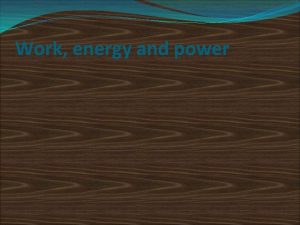Energy Work Power Energy The amount of work


























- Slides: 26

Energy, Work & Power

Energy The amount of work a physical system is capable of performing. Energy can neither be created nor consumed or destroyed

Types of Energy Kinetic Energy Potential Energy Renewable Non renewable

Forms of Energy Radiant Electrical Chemical Sound Thermal Mechanical Nuclear Magnetic

Radiant Electromagnetic energy that we get from the sun Radio waves, micro waves etc Electrical § movement of elections § Lightning and static electricity are examples

Chemical • Energy stored in the bonds of atoms and molecules form of potential energy until the bonds are broken • Fossil fuels and biomass store chemical energy. Biomass, petroleum, natural gas, propane and coal are examples of stored chemical energy.

Nuclear • Energy stored in the nucleus of an atom. • Nuclear energy can give off energy in the form of light or heat, but it is the change in the atom's makeup that produces the energy. • Submarines, power plants, and smoke detectors all use nuclear energy. Nuclear power plants use uranium, a radioactive element, to create electricity.

Thermal energy is the internal energy in substances -the vibration and movement of atoms and molecules within substance Boiling water, burning wood, and rubbing your hands together really fast are all examples of heat energy

Sound Energy is the movement molecules in the air that produces vibrations. Alarms music, speech, ultrasound medical equipment all use sound energy

Mechanical energy is the movement of machine parts. Mechanical energy is also the total amount of kinetic and potential energy in a system Mechanical = kinetic + potential

Magnetic The attraction of objects made of iron. Medical equipment, compass, refrigerator magnets are all examples of magnetic energy

Kinetic Energy • Exists whenever an object which has mass is in motion with some velocity. • Everything you see moving about has kinetic energy. • The kinetic energy of an object in this case is given by the relation: • KE = (1/2)mv 2 • m= mass of the object • V= velocity of the object • The greater the mass or velocity of a moving object, the more kinetic energy it has.


Potential Energy • Exists whenever an object which has mass has a position within a force field • Example is the position of objects in the earth's gravitational field. The potential energy of an object in this case is given by the relation: • PE = mgh – PE = Energy (in Joules) – m = mass (in kilograms) – g = gravitational acceleration of the earth (9. 8 m/sec 2) – h = height above earth's surface (in meters)

Law of Conservation of Energy can neither be created nor destroyed. Energy is always changing from one kind to another. The total energy of an object never changes. Potential energy + Kinetic energy = Total energy

Work A force acting upon an object to cause a displacement For a force to qualify it must 1. Displacement MUST happen 2. Force MUST cause the displacement

Work or NOT? A teacher applies a force to a wall and becomes exhausted. A book falls off a table and free falls to the ground. A waiter carries a tray full of meals above his head by one arm across the room. A rocket accelerates through space.

Describing Work Mathematically W = f*d*cos Θ Force and displacement are rightward. Force left, displacement right Force up, displacement left When Θ = 0 or 180 degrees Cos Θ = 1!

Perpendicular force Since cos Θ = 0, F*d* Θ = 0 No work done! REMEMBER! A vertical force CANNOT cause horizontal displacement! Cos Θ = 0 when Θ = 90 degrees

Force at an angle The chain’s force pulls upward and rightward Only the horizontal component of the in the chain displaces Fido (backward) The ANGLE determines the portion of the force which actually causes a displacement.

What angle is used? The angle between the force and the displacement vector. NOT the angle of ascent in this case Direction of pull = Displacement direction

Units of Work (and Energy) The Joule One joule = 1 Newton of force displacement of 1 meter 1 Joule = 1 Newton*meter Each set of units is equivalent to a force unit times a displacement unit.

Application 1. Apply the work equation to determine the amount of work done by the applied force in each of the three situations described below. Cos 0 = 1. Cos 30 =. 866

Power The RATE of Doing Work… Rate is the amount of work done in a specified period of time The more powerful something is, the faster it can do work

Units of Power Standard (SI) unit of power is the watt Example: 500 W motor can perform 500 J of work in 1 s … or 250 J of work in 0. 5 s … or 5000 J of work in 10 s Watts are very small units Kilowatts are used most commonly

Thank you
 Real power formula
Real power formula Two identically sized metal spheres
Two identically sized metal spheres The amount of energy required
The amount of energy required Regents physics work power energy
Regents physics work power energy Work, power and energy activities
Work, power and energy activities Regents physics work power energy
Regents physics work power energy Physics 2204 unit 3: work, power, energy
Physics 2204 unit 3: work, power, energy Power definition physics
Power definition physics How are energy work and power related
How are energy work and power related Work power energy and machines
Work power energy and machines W=fdcosθ meaning
W=fdcosθ meaning Work power and energy
Work power and energy Work energy power equations
Work energy power equations Jenis usaha apa
Jenis usaha apa Work energy
Work energy Hát kết hợp bộ gõ cơ thể
Hát kết hợp bộ gõ cơ thể Slidetodoc
Slidetodoc Bổ thể
Bổ thể Tỉ lệ cơ thể trẻ em
Tỉ lệ cơ thể trẻ em Gấu đi như thế nào
Gấu đi như thế nào Chụp phim tư thế worms-breton
Chụp phim tư thế worms-breton Chúa yêu trần thế alleluia
Chúa yêu trần thế alleluia Môn thể thao bắt đầu bằng từ chạy
Môn thể thao bắt đầu bằng từ chạy Thế nào là hệ số cao nhất
Thế nào là hệ số cao nhất Các châu lục và đại dương trên thế giới
Các châu lục và đại dương trên thế giới Công thức tiính động năng
Công thức tiính động năng Trời xanh đây là của chúng ta thể thơ
Trời xanh đây là của chúng ta thể thơ

